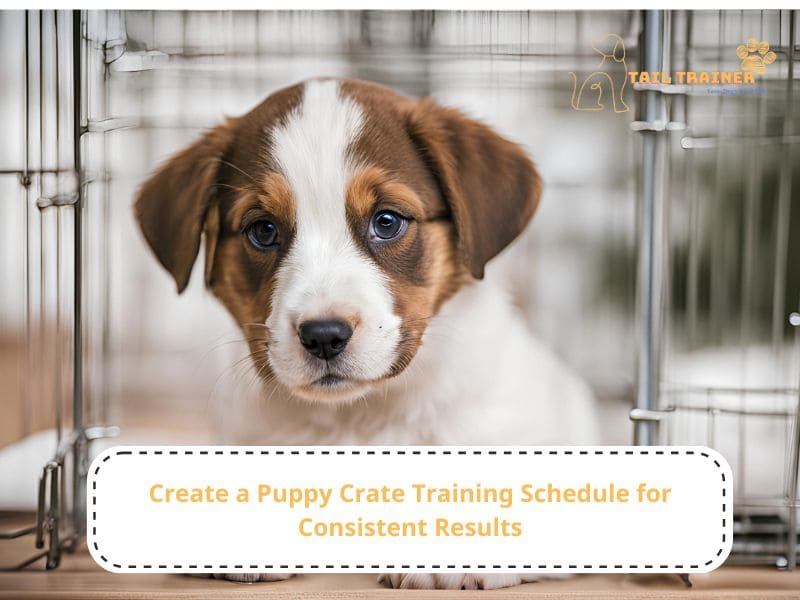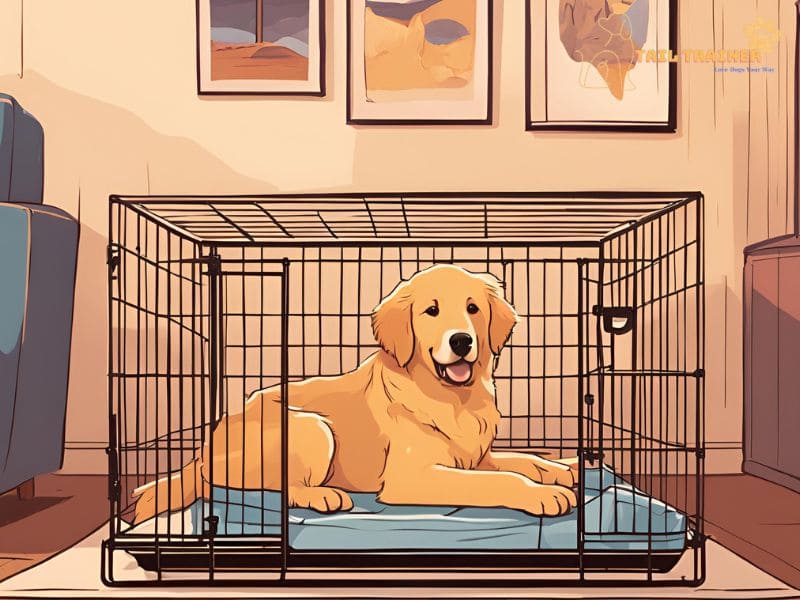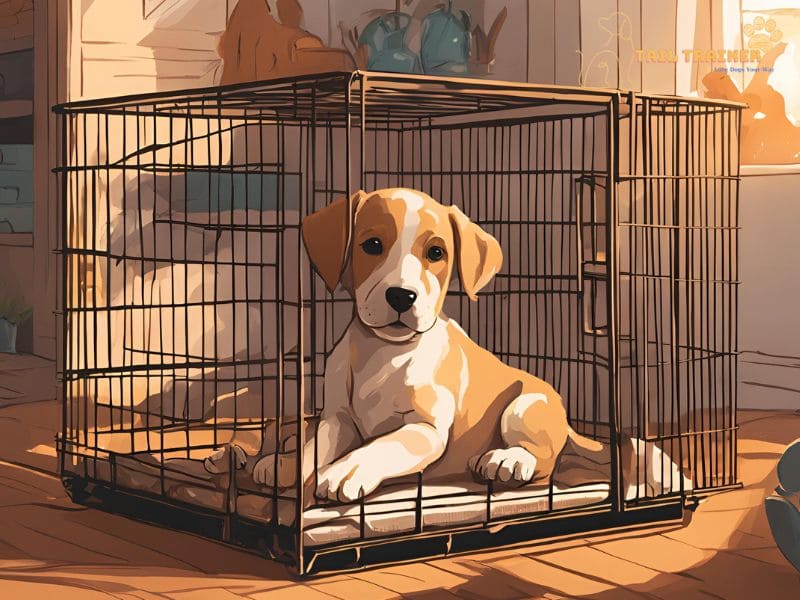Training a puppy with a crate schedule is more than just teaching them to stay in one place; it’s about fostering security, independence, and positive behaviors that support their natural instincts. At Tail Trainer, we aim to empower dog parents with proven techniques and insights into puppy crate training so that you feel equipped to raise a well-behaved, happy puppy. This guide offers a structured schedule and insights into crate training essentials, step-by-step guidance, and real-life examples from trainers and pet parents.
Key Takeaways
Setting up a puppy crate training schedule ensures effective training by creating a predictable environment. Establish routines for sleep, play, and feeding, helping your puppy learn crate time as a comforting, regular part of their day.
Understanding the Importance of Puppy Crate Training

Introducing crate training to a young puppy may seem challenging, but it can build an essential foundation of trust and discipline. Crates provide a secure space that aligns with their denning instincts, which is why crate training has proven successful in managing behaviors and reducing separation anxiety.
Properly crate-trained puppies see the crate as their own safe zone, a place to retreat and rest. This safe area allows for effective toilet training, reducing accidents in the home by creating a schedule that aligns with their biological needs.
Building Positive Associations with the Crate
Making a crate inviting can help puppies view it as a positive place:
- Comfortable bedding creates a cozy spot.
- Placing favorite toys and treats in the crate helps reinforce positive feelings.
- Short crate sessions with gradual increases in time can ease them into the idea.
As they adapt, it’s essential to follow a structured schedule to ensure consistency. Let’s explore how this routine benefits your puppy and makes crate training more manageable.
Essential Components of a Puppy Crate Training Schedule

A balanced crate training schedule includes consistent feeding times, nap times, and play sessions. By designating specific periods for each activity, you’ll create predictability that helps your puppy understand what’s coming next, reducing anxiety and promoting calmness.
Feeding and Potty Breaks
- Morning Routine: Start with a toilet break immediately upon waking. Afterward, offer breakfast, followed by another potty break around 15 minutes after eating. The crate can help control their access to food and develop a feeding routine.
- Meal Frequency: Young puppies typically require three meals per day, spaced about 4 hours apart. Offer meals on a predictable schedule, and always provide a potty break post-meal.
- Nighttime Routine: Ensure the last meal is given at least 3 hours before bedtime, allowing them ample time to digest and go potty.
This routine works by supporting your puppy’s digestive system, helping them learn when they’ll need a break, and assisting in keeping their crate clean and dry.
Rest Periods and Crate Time
Creating specific crate times during the day supports:
- Nap Training: Puppies need frequent naps to support growth. Using the crate for nap times teaches them it’s a place for rest, not just confinement.
- Nighttime Crating: Place the crate in your bedroom to ease nighttime anxieties, providing them comfort without giving full freedom of movement.
- Gradually, the puppy will build trust and find it easier to settle down.
The Role of Positive Reinforcement in Crate Training

For successful crate training, positive reinforcement is crucial. Positive associations ensure that your puppy doesn’t develop any negative feelings toward the crate. Here’s how to approach it:
- Reward Calm Behavior: Only reward your puppy for calmness in the crate; avoid reacting to whining or barking by letting them out, as it may reinforce unwanted behavior.
- Gradual Training Sessions: Start with brief crate sessions, such as 5 to 10 minutes, then gradually increase the time.
- Consistency in Rewards: Using the same treats or toys every time they enter the crate strengthens the association between the crate and rewards.
Gradually, puppies begin to understand that staying calm in their crate leads to rewards and trust-building, creating a smoother training experience.
Exploring Important Concepts in Crate Training
Establishing a good routine requires understanding a few key ideas that can support effective crate training. Here, we’ll look into house training, reducing separation anxiety, and using the crate for calm time.
House Training and the Crate Connection
House training becomes simpler when puppies use their crates, as they typically avoid soiling their living areas. A few guidelines can help:
- Scheduled Breaks: Arrange potty breaks every 2-3 hours, depending on age. Puppies have small bladders, so shorter intervals are necessary.
- Consistency: Always use the same spot outdoors for potty breaks to strengthen their connection with where they’re supposed to go.
- Crate Control: Limiting freedom inside the home early on supports house training and decreases the chances of indoor accidents.
Consistency is crucial in this phase to reinforce where and when it’s appropriate to go potty. This schedule reduces stress, encouraging quicker house training success.
Reducing Separation Anxiety
Crates provide a safe, secure space for puppies, which can help lessen separation anxiety. Using the crate gradually for solo time, paired with consistent exposure, allows puppies to become more comfortable being alone. Here are helpful techniques:
- Start with Short Absences: Leave your puppy alone in the crate for short periods and gradually extend the duration. This practice teaches them that your absence is not permanent.
- Avoid Dramatic Exits or Entrances: Keeping goodbyes and greetings calm reduces excitement and anxiety.
Using the crate in this way, they learn to associate solitude with calm, reinforcing self-soothing behavior.
Attributes That Enhance Crate Training Success
Consistency, time management, and patience play a significant role in crate training. The following attributes are foundational:
Consistency
Puppies thrive on predictable routines. Using the crate at regular intervals and establishing a fixed feeding, potty, and sleep schedule enables puppies to understand expectations and adhere to them more readily.
Time Management
Planning crate time into your daily routine benefits not only your puppy but also helps manage your day. Balanced crate time, play, and rest allows them to develop both mentally and physically, ultimately leading to a more structured household.
Patience and Flexibility
Training takes time, and some puppies adjust faster than others. Crate training requires gentle, patient guidance, allowing your puppy to progress at a natural pace. Flexibility allows room for occasional setbacks and reinforces a positive training environment.
Tackling Complex Aspects of Crate Training
As you move through crate training, you may encounter a few advanced hurdles. Addressing these helps maintain a calm approach to training, even when challenges arise.
Dealing with Whining and Barking
Puppies sometimes whine in their crates, either because they’re adjusting to a new schedule or because they’re anxious. Here’s how to handle it constructively:
- Ignore Excessive Whining: If they’re well-fed, recently pottied, and healthy, try ignoring the behavior to avoid reinforcing it.
- Provide Comfort Items: Safe toys or a shirt with your scent may help your puppy feel more secure.
- Timing Crate Time Well: Ensuring your puppy is tired before crate time, such as after play or a meal, increases their likelihood of resting peacefully.
Patience and reassurance help build resilience to crate time, decreasing disruptive behavior over time.
Gradual Crate Freedom
Once a puppy is fully crate-trained, some pet parents choose to increase freedom gradually. This step allows puppies to explore beyond their crate, gaining independence while still feeling secure. Here’s how to do it smoothly:
- Begin with Supervised Sessions: Initially, allow short periods outside the crate but within your view.
- Add Small Areas Gradually: Extend their access gradually, increasing freedom in one area at a time.
Using a combination of supervised time and slow increments, puppies can learn to self-regulate and remain well-behaved outside the crate.
Frequently Asked Questions
How long should a puppy be in a crate each day?
Young puppies benefit from spending about 3-4 hours at a time in their crate, but this varies with age and energy levels. Including breaks for potty, play, and feeding creates a balanced routine without overstaying in the crate.
What should I do if my puppy doesn’t like the crate?
Start with brief, positive crate experiences. Use treats, toys, and gentle encouragement to associate the crate with rewards. Gradual exposure builds trust, making the crate a more welcoming place over time.
Can crate training help with housebreaking?
Yes, crate training is excellent for housebreaking. Puppies are less likely to soil their crate, which encourages them to wait for designated potty breaks and makes house training easier.
How do I prevent separation anxiety with crate training?
Introduce crate time with short absences, increasing gradually. This approach helps puppies become comfortable being alone and lessens separation anxiety through a calm, positive routine.
What if my puppy cries during crate training?
If your puppy is crying, try ignoring it initially to avoid reinforcing the behavior. Provide comfort items like a toy or blanket and ensure they’re comfortable, fed, and not needing a potty break.
For more crate training resources and practical tips, keep visiting Tail Trainer. We’re dedicated to supporting pet parents through every step of the training journey!
